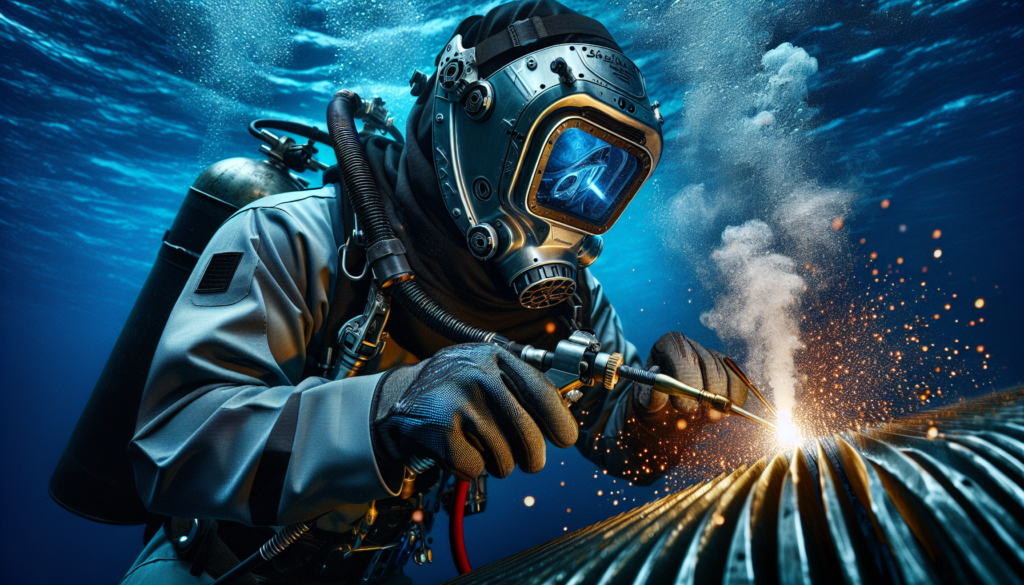Imagine being able to weld in deep-sea environments without the need for costly and time-consuming dry-docking procedures. Hyperbaric welding, the remarkable technique that combines welding and diving, allows you to do just that. This groundbreaking method involves performing welding operations underwater at high pressures, enabling divers to repair and construct structures in the ocean depths. Hyperbaric welding is revolutionizing the way underwater welding is conducted, providing an efficient and practical solution for underwater repairs and construction projects.

What is Hyperbaric Welding?
Definition of Hyperbaric Welding
Hyperbaric welding is a specialized welding process that takes place in a pressurized environment to join materials together underwater. It combines the principles of both welding and diving to create strong and durable welds in situations where traditional welding methods may be challenging or impossible to use. By utilizing specialized equipment and procedures, hyperbaric welding allows for the successful completion of welding tasks in environments such as deep-sea construction, offshore oil and gas exploration, and shipbuilding.
History of Hyperbaric Welding
The concept of hyperbaric welding dates back to the 1930s when a patent for underwater welding was first filed. However, it wasn’t until the 1960s that significant advancements were made in the field, primarily driven by the need for welding repairs on offshore oil and gas platforms. Since then, hyperbaric welding techniques have continued to evolve and improve, making it an essential tool in many industries that require welding in challenging underwater conditions.
Types of Hyperbaric Welding
Dry Hyperbaric Welding
Dry hyperbaric welding, also known as chamber welding, involves placing the welding operation inside a sealed chamber that maintains a dry environment. The welding is performed by a qualified welder who works inside the chamber under high pressure conditions. This method is commonly used for various applications, including the repair and construction of pipelines, offshore structures, and submerged vessels.
Wet Hyperbaric Welding
In wet hyperbaric welding, the welding operation is conducted directly underwater without the use of a chamber. A skilled welder, equipped with specialized diving gear, carries out the welding process while immersed in water and subjected to high-pressure conditions. Wet hyperbaric welding is often used in situations where the size or location of the structure makes it impractical or impossible to use a chamber.
Semi-Dry Hyperbaric Welding
Semi-dry hyperbaric welding is a hybrid approach that combines the advantages of both dry and wet welding methods. In this technique, a partially enclosed environment is created around the welding site, allowing for some control over the water surrounding the weld. This method is particularly useful when working in shallow water or areas with limited access, as it provides an improved working environment compared to wet welding while avoiding the need for a full chamber.
Benefits of Hyperbaric Welding
Enhanced Weld Quality
Hyperbaric welding offers enhanced weld quality due to the controlled environment in which it takes place. The absence of atmospheric contaminants, such as oxygen and moisture, can significantly reduce the probability of weld defects, resulting in stronger and more reliable welds. Additionally, the consistent pressure maintained during the process ensures uniformity and stability in the weld, further improving its quality.
Reduced Defects
One of the significant advantages of hyperbaric welding is its ability to minimize weld defects. The pressurized environment prevents the formation of gas pockets, such as porosity and hydrogen-induced cracking, which are common in conventional welding methods. By reducing these defects, hyperbaric welding helps to create welds with improved integrity and reduced susceptibility to failure.
Increased Efficiency and Productivity
Hyperbaric welding can significantly increase efficiency and productivity compared to traditional welding methods. The controlled environment allows for precise control over welding parameters, resulting in faster and more reliable welds. Additionally, the reduced need for post-weld inspections and repairs due to the high-quality welds contributes to overall time and cost savings.
Applications of Hyperbaric Welding
Underwater Construction
Hyperbaric welding plays a crucial role in underwater construction projects. Whether it’s the installation of offshore structures, such as oil and gas platforms or underwater pipelines, hyperbaric welding ensures the durability and strength of the welded joints in these critical infrastructure components. Additionally, it is used in the construction of underwater tunnels, dams, and other submerged structures.
Offshore Oil and Gas Industry
The offshore oil and gas industry heavily relies on hyperbaric welding for maintenance, repair, and installation tasks. Due to its ability to withstand the harsh underwater conditions and create reliable welds, hyperbaric welding is used for repairing pipelines, subsea connectors, and risers. It also enables the construction of offshore drilling platforms and the welding of various components and structures involved in oil and gas extraction.
Ship and Submarine Construction
In ship and submarine construction, hyperbaric welding is employed to ensure the integrity and structural strength of welded joints. By enabling welds to be made underwater, hyperbaric welding allows for the efficient assembly and repair of these large vessels. It is particularly useful in the construction of submarines, where the ability to weld in the underwater environment is crucial.

Equipment and Procedures for Hyperbaric Welding
Hyperbaric Welding Chamber
A hyperbaric welding chamber is an essential piece of equipment for dry hyperbaric welding. It provides a controlled, dry environment for the welder to work in, ensuring the integrity of the weld and the safety of the operator. These chambers are designed to withstand high pressures and are equipped with viewing ports, lighting, and manipulators to facilitate the welding process.
Breathing Gas Supply System
In hyperbaric welding, a breathing gas supply system is used to provide the necessary oxygen and other gases to the welder working in a pressurized environment. The system ensures that the welder receives a continuous supply of breathing gas, such as a mixture of oxygen and helium, to maintain their respiration during the welding operation.
Welding Electrodes and Consumables
Hyperbaric welding requires specialized electrodes and consumables to operate effectively in the underwater environment. The consumables must be designed to withstand high pressures and be compatible with the specific welding process being used. These include welding rods, fluxes, shielding gases, and other materials necessary to create structurally sound welds.
Welding Procedures
Hyperbaric welding procedures are developed to ensure the proper execution of the welding operation. These procedures outline the specific steps and parameters required to achieve high-quality welds in the hyperbaric environment. They take into account factors such as weld preparation, electrode selection, welding techniques, and post-weld inspections to maintain the desired weld integrity.
Preparing for a Hyperbaric Welding Job
Safety Precautions
Safety is paramount in hyperbaric welding due to the unique challenges posed by the underwater environment and high-pressure conditions. Proper safety precautions must be followed, including comprehensive training for the welders and adherence to strict protocols. Safety equipment, such as diving suits, helmets, and gas monitoring devices, should be used to protect the welders from potential hazards.
Inspection and Maintenance of Equipment
Regular inspection and maintenance of hyperbaric welding equipment are crucial to ensure its proper functioning and to prevent any potential issues during welding operations. The welding chamber, breathing gas supply system, and other equipment must be regularly checked for leaks, damage, and proper calibration. This helps to maintain the integrity of the welding environment and the safety of the welders.
Training and Certification Requirements
Hyperbaric welding is a specialized skill that requires extensive training and certification. Welders must undergo comprehensive training programs that cover both welding techniques and diving procedures. Certification is typically obtained through recognized organizations that provide rigorous assessments of the welder’s knowledge, skills, and ability to work in hyperbaric conditions.
Challenges and Considerations in Hyperbaric Welding
Gas Pressure Effects
One of the primary challenges in hyperbaric welding is dealing with the effects of increased gas pressure on the welding process. The increased pressure can affect the physical properties of the welding consumables, the stability of the welding arc, and the weld pool behavior. Special measures, such as adjusting welding parameters and using specialized materials, are required to compensate for these pressure effects and ensure successful welds.
Contamination Control
Controlling contamination in the hyperbaric welding environment is crucial to achieve high-quality welds. Any contaminants, such as oil, grease, or seawater, can interfere with the welding process and compromise the integrity of the weld. Stringent cleaning procedures and the use of appropriate shielding gases and consumables are employed to minimize the risk of contamination and ensure clean and sound welds.
Diver Fatigue and Decompression Sickness
Hyperbaric welding operations can be physically demanding for the welder due to the increased pressure and the need to work for extended periods in challenging underwater conditions. Diver fatigue can affect the welder’s performance and safety during the welding process. Additionally, decompression sickness, also known as “the bends,” can occur if the welder ascends to the surface too quickly after completing a hyperbaric welding job. Proper rest periods, decompression protocols, and adherence to prescribed safety procedures minimize these risks.
Future Trends in Hyperbaric Welding
Advancements in Equipment and Technology
The future of hyperbaric welding holds promising advancements in equipment and technology. Improved welding chambers, breathing gas supply systems, and other specialized tools are expected to be developed to enhance the efficiency and safety of hyperbaric welding operations. Additionally, advancements in monitoring and control technologies will allow for real-time monitoring of weld quality and process parameters, further improving the reliability and productivity of hyperbaric welding.
Automation in Hyperbaric Welding
Automation is another area with significant potential for hyperbaric welding. The development of robotic systems capable of performing welding tasks in underwater environments could revolutionize the industry by increasing efficiency, reducing the risk to human welders, and improving weld quality and consistency. Automated inspection and monitoring systems are also being explored to enhance the reliability and accuracy of weld inspections in hyperbaric environments.
Research and Development Efforts
Research and development efforts in hyperbaric welding aim to address the existing challenges and improve the overall capabilities of the process. Ongoing research focuses on understanding the behavior of different materials under high-pressure conditions, developing advanced welding techniques specific to hyperbaric environments, and exploring novel welding consumables and shielding gases to further enhance the quality and durability of hyperbaric welds.
Hyperbaric Welding vs Conventional Welding
Differences in Technique and Environment
Hyperbaric welding differs from conventional welding primarily in the technique used and the environment in which it takes place. Conventional welding is typically performed in atmospheric conditions, allowing for easy manipulation of the welding arc and precise control over welding parameters. In contrast, hyperbaric welding requires specialized equipment, procedures, and training to work in a pressurized and often underwater environment.
Pros and Cons of Hyperbaric Welding
The advantages of hyperbaric welding lie in its ability to create high-quality welds in challenging conditions. The controlled environment reduces the risk of weld defects, improves productivity, and ensures the integrity of the welded joints. However, hyperbaric welding also has some drawbacks, including the need for specialized equipment, the potential risks associated with working in high-pressure and underwater environments, and the additional training and certification requirements for welders.
Application-specific Considerations
When deciding between hyperbaric welding and conventional welding, several application-specific considerations come into play. Factors such as the location of the welding job, the size and complexity of the structure being welded, the desired weld quality and integrity, and the available resources and budget will all influence the choice of welding method. Each situation should be evaluated on its specific requirements and constraints to determine which welding technique is the most suitable.
Conclusion
Hyperbaric welding is a specialized process that allows for successful welding operations in challenging underwater environments. With its variety of techniques, such as dry, wet, and semi-dry welding, hyperbaric welding has become an invaluable tool in industries such as underwater construction, offshore oil and gas, and ship and submarine manufacturing. The benefits of hyperbaric welding include enhanced weld quality, reduced defects, and increased efficiency and productivity. While challenges such as gas pressure effects, contamination control, and diver fatigue exist, advancements in equipment, automation, and ongoing research and development efforts promise a bright future for hyperbaric welding. When deciding between hyperbaric welding and conventional welding, careful consideration of the specific application and its requirements is essential. Hyperbaric welding offers unique advantages, but it also comes with additional considerations and requirements that must be taken into account. Overall, hyperbaric welding continues to be a vital and evolving field that enables the successful completion of welding tasks in challenging underwater environments.
